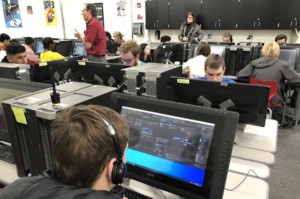Equal Access to College Preparatory Curriculum

By: David Haglund
It may surprise you to learn that more than one million high school students in California – upwards of 50% — attend schools that do not offer sufficient courses for admission to state schools, the so-called A-G curriculum. The California Student Bill of Rights Initiative, a project of Education Forward, seeks to remedy this inequity in access through an initiative slated for the November 2012 ballot.
While many California students suffer from a lack of A-G coursework, low-income and minority students suffer most. Latino and African American students graduate high school, complete A-G courses and go to college at rates significantly below average. These students are also more likely to live in low-income neighborhoods, a geographic factor that essentially determines their future: California’s existing public education system creates barriers that prevent students from attending schools or taking online courses outside of their district of residence.
Students can currently attend publically-funded virtual charter schools, but even this opportunity is geographically restricted – students can only attend these schools if they reside in a county contiguous to the one in which the school is based. In the age of the Internet, why are we still limiting students’ educational opportunities based on geography?
The California Student Bill of Rights Initiative addresses this problem directly by utilizing technology to break down the barriers between students and the educational opportunities available to them. Under this proposed law, students will be allowed to take online courses offered by districts other than their own to complete the college preparatory curriculum. These courses must be accredited and taught by teachers with appropriate credentials.
School funding is currently based on the Average Daily Attendance (ADA) formula, which gives schools money based on attendance regardless of educational outcomes or student needs. The Student Bill of Rights Initiative restructures the school financing system so that ADA money can be appropriated to schools based on the classes students take – in the classroom or online – a fairly simple modification since ADA is already based on time spent in class.
For some perspective, consider this: In 1966 the young Steve Jobs entered a low-income middle school in Mountain View, California, where he was confronted with gang violence, overcrowding and poor instruction, and he threatened to drop out. His parents scraped together enough money to buy a house just three miles away on the other side of the district boundary, which meant that Jobs could attend a school in a more affluent neighborhood with better educational opportunities. Other kids have not been so lucky. Forty-five years later, the world has been transformed by technology – from the Internet to tablet computers. Innovators like Jobs have fundamentally changed the way we do business, communicate, shop and learn. The California public education system, however, remains stuck in the past.
With the passage of the Student Bill of Rights, California will be one step closer to educational equality across demographic, economic and geographic boundaries. We will be one step closer to giving our kids the chance they deserve to succeed in the highly competitive 21st century global economy.





0 Comments
Leave a Comment
Your email address will not be published. All fields are required.